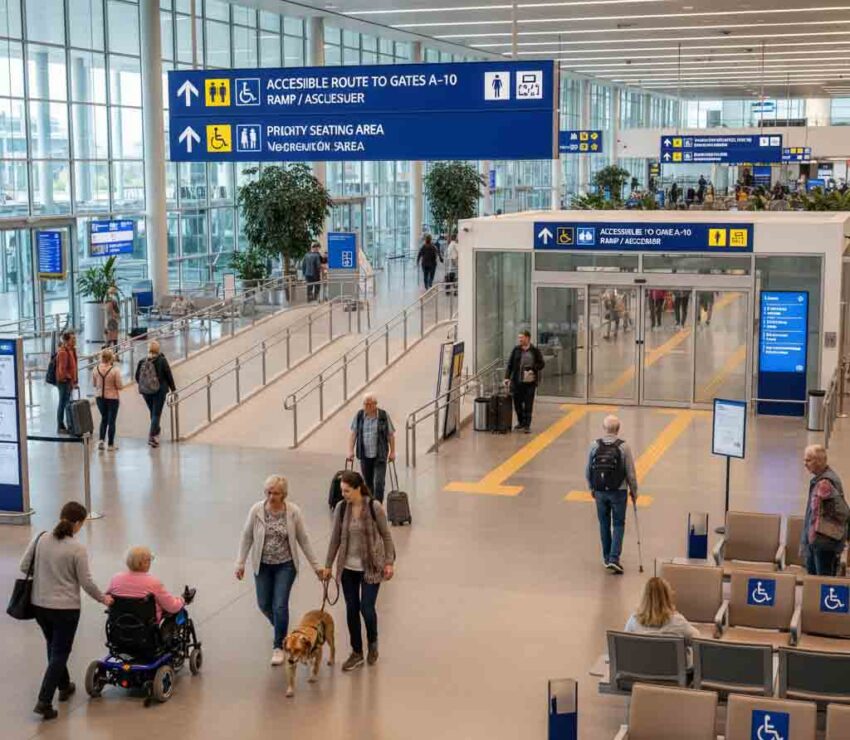These Airports Are Breaking Barriers in Accessibility Travel—You Won’t Believe How They’re Revolutionizing Aviation Industry for All
These airports are breaking barriers in accessibility travel, and you won’t believe how they’re revolutionizing the aviation industry for all. As the world of air travel evolves, airports are leading the charge by implementing groundbreaking innovations that make flying easier for everyone, regardless of ability.
These airports are breaking barriers in accessibility travel, and you won’t believe how they’re revolutionizing the aviation industry for all. As the world of air travel evolves, airports are leading the charge by implementing groundbreaking innovations that make flying easier for everyone, regardless of ability.
These airports are not just improving accessibility—they are transforming the entire travel experience. With their state-of-the-art facilities, these pioneers in accessible design are setting new standards that challenge what we thought was possible.
From advanced technologies to more inclusive layouts, these airports are breaking barriers that once made air travel difficult for many. The aviation industry is undergoing a revolution, and these airports are at the forefront, ensuring that every traveler can enjoy a seamless journey.
By breaking barriers, they are truly reshaping how we think about accessibility in the skies. It’s a game-changing shift that will have lasting impacts for all.
Accessibility at airports is more than just a trend; it’s a crucial aspect of modern air travel. As airports around the world work to make flying easier for everyone, there are several that stand out for their outstanding accessibility features. From cutting-edge technology to thoughtful design, these airports ensure that people with disabilities, the elderly, and those needing extra assistance can travel without barriers. This article delves into the world’s most accessible airports, examining the facilities and innovations that make them leaders in inclusive travel.
The Rise of Accessible Airports Worldwide
Airports have become more than just transit points; they are hubs that cater to diverse needs. In recent years, many airports have embraced universal design principles, which allow people with various physical, sensory, and cognitive needs to navigate more easily. As the demand for accessible travel continues to rise, airports globally are stepping up their efforts to ensure that everyone can enjoy a seamless experience. But which airports are setting the standard for accessibility? Let’s explore some of the best.
1. Tokyo Haneda Airport: A Benchmark in Accessibility
Tokyo Haneda Airport has long been hailed as one of the most accessible airports in the world. Its commitment to inclusivity is evident in its design and services. The airport features dedicated assistance points for passengers with reduced mobility, as well as priority seating and washrooms that include changing facilities for those with disabilities.
What makes Haneda stand out is its implementation of the Sunflower Lanyard Scheme. This scheme helps passengers with hidden disabilities such as autism or mental health conditions to receive the support they need without needing to explain their condition. This thoughtful inclusion makes Tokyo Haneda a model for accessibility worldwide. Moreover, the airport’s staff is highly trained to assist passengers who need extra help, ensuring that all travellers are treated with respect and care.
Key Features at Haneda:
- Dedicated PRM (Persons with Reduced Mobility) assistance points
- Sunflower Lanyard Scheme for hidden disabilities
- Wheelchair services and accessible seating
- Multilingual signage for international travellers
2. Singapore Changi Airport: A Leader in Inclusive Design
Singapore Changi Airport is known for its world-class facilities, and accessibility is no exception. Changi has gone above and beyond to create an inclusive environment for all passengers. It offers clearly marked zones for people with disabilities, private rest spaces, and attentive assistance services tailored to meet the needs of different groups.
In addition, Changi Airport has invested in multilingual signage, ensuring that everyone can easily navigate the airport. Its barrier-free layout allows smooth movement for wheelchair users, and its various lounges provide quiet, comfortable spaces for relaxation. This airport’s seamless blend of technology and thoughtful design makes it a top contender for the most accessible airport.
Key Features at Changi:
- Clear, multilingual signage
- Private rest spaces for passengers needing quiet time
- Wheelchair assistance and barrier-free layouts
- Multilingual support for global visitors
3. Zurich Airport: Combining Accessibility with Swiss Precision
Zurich Airport in Switzerland is another standout example of accessibility. With a strong focus on passenger comfort, the airport offers fast-track mobility services and barrier-free designs that make it easier for passengers with disabilities to navigate the space.
One of the standout features of Zurich Airport is its highly trained staff. Personnel are equipped to assist passengers with various needs, whether that’s helping someone with a hearing impairment or assisting a family with young children. The airport also offers a variety of accessible seating options, restrooms designed with accessibility in mind, and helpful signage that guides passengers to key areas.
Key Features at Zurich:
- Fast-track mobility services
- Accessible seating and restrooms
- Multilingual staff trained to assist diverse needs
- Well-designed layouts for easy navigation
4. Amsterdam Schiphol Airport: A Pioneer in Passenger Assistance
Amsterdam Schiphol Airport is a leader in providing accessible travel services. The airport features easily identifiable “Assistance Point” kiosks, which provide immediate help for passengers who need assistance. Whether it’s for a wheelchair or guidance to the correct gate, these kiosks ensure that passengers receive quick, efficient support.
In addition to the kiosks, Schiphol provides quiet lounges and spacious seating areas for passengers who need extra comfort. Its wide walkways and clear signage make it easy for everyone, including people with reduced mobility, to find their way around. Schiphol’s focus on comfort and inclusivity ensures that every passenger, regardless of ability, feels welcome and supported.
Key Features at Schiphol:
- Assistance Point kiosks for quick support
- Quiet lounges and spacious seating
- Wide walkways for easy navigation
- Clear signage for all passengers
5. Manchester Airport: Leading the Way in the UK
In the United Kingdom, Manchester Airport has been recognized for its commitment to accessibility. The airport has invested heavily in upgrading its services, ensuring that passengers with disabilities or those needing additional help have a smooth experience. Manchester offers dedicated check-in areas and accessible bathrooms, which are crucial for ensuring comfort and convenience for everyone.
The airport also excels in staff training, ensuring that its personnel are equipped to provide the best possible service to all passengers. Whether it’s assisting with baggage or helping someone with visual impairments navigate the terminal, Manchester’s staff are dedicated to making the airport experience as stress-free as possible.
Key Features at Manchester:
- Dedicated check-in areas for those needing extra help
- Accessible bathrooms and seating areas
- Enhanced staff training for providing quality assistance
- Clear signage and assistance for all passengers
Universal Design: What Makes an Airport Truly Accessible?
While each airport has its unique features, there are certain principles that all accessible airports share. Universal design is at the core of these efforts. Universal design focuses on creating environments that are easy for everyone to use, regardless of their abilities or disabilities.
1. Clear Signage and Wayfinding
One of the most crucial aspects of an accessible airport is its wayfinding system. This includes clear signage that helps passengers navigate the airport with ease. Airports that use large fonts, colour contrasts, and symbols that are universally recognized ensure that everyone can understand where they need to go, whether they are able-bodied or have a disability.
2. Inclusive Facilities
Accessible airports are designed with a variety of facilities in mind, including restrooms, seating areas, and service counters. These facilities are created to accommodate people with different needs, from accessible toilets to seating with space for wheelchairs and assistance animals. The goal is to create an environment where everyone can move freely and independently.
3. Staff Training and Awareness
Staff training is essential for ensuring that all passengers receive the help they need. Airports that are committed to accessibility often provide comprehensive training for their employees, ensuring that they are equipped to assist passengers with a wide range of needs. This includes training in communication methods for those with hearing impairments and understanding how to assist passengers with mobility challenges.
4. Technological Integration
In today’s digital age, technology plays an essential role in enhancing airport accessibility. Airports around the world have integrated apps, real-time updates, and interactive kiosks to provide information and support. These technological tools ensure that passengers can access the information they need quickly and efficiently, making the travel experience much smoother.
Looking Ahead: The Future of Accessible Airports
As accessibility becomes an even more integral part of the travel experience, airports worldwide are continuing to innovate and improve. The future of accessible airports looks bright, with new technologies and designs making travel easier for everyone.
1. Personalized Assistance
In the future, we can expect more personalized assistance for passengers with disabilities. From apps that provide tailored support to AI-powered robots that assist with navigation, technology will continue to transform how airports assist their most vulnerable passengers.
2. Sustainable and Accessible Design
As airports embrace sustainability, they will also continue to prioritize accessibility. Future airports are likely to feature eco-friendly designs that incorporate both environmental sustainability and accessibility. This could mean energy-efficient systems and the use of sustainable materials in accessible infrastructure.
3. Community Engagement
Finally, airports will continue to work closely with disability organizations and advocacy groups to ensure that they are meeting the needs of all passengers. By engaging with the community and listening to feedback, airports can ensure that their services remain relevant and effective.
Conclusion: Accessible Airports are the Future of Travel
Accessibility is no longer an afterthought in airport design; it is a fundamental aspect of creating a welcoming environment for all passengers. Airports like Tokyo Haneda, Singapore Changi, Zurich, Amsterdam Schiphol, and Manchester are leading the charge in creating inclusive spaces for everyone. With a commitment to universal design, clear signage, thoughtful facilities, and highly trained staff, these airports are setting the standard for what accessible travel should look like.
As the world of air travel continues to evolve, we can expect even more innovations that will make airports easier to navigate for people of all abilities. The future of accessible airports is bright, and these airports are leading the way. Whether you’re travelling for business or pleasure, an accessible airport ensures that you can get to your destination with ease and confidence.
The post These Airports Are Breaking Barriers in Accessibility Travel—You Won’t Believe How They’re Revolutionizing Aviation Industry for All appeared first on Travel and Tour World


Comments and Responses
Please login. Only community members can comment.